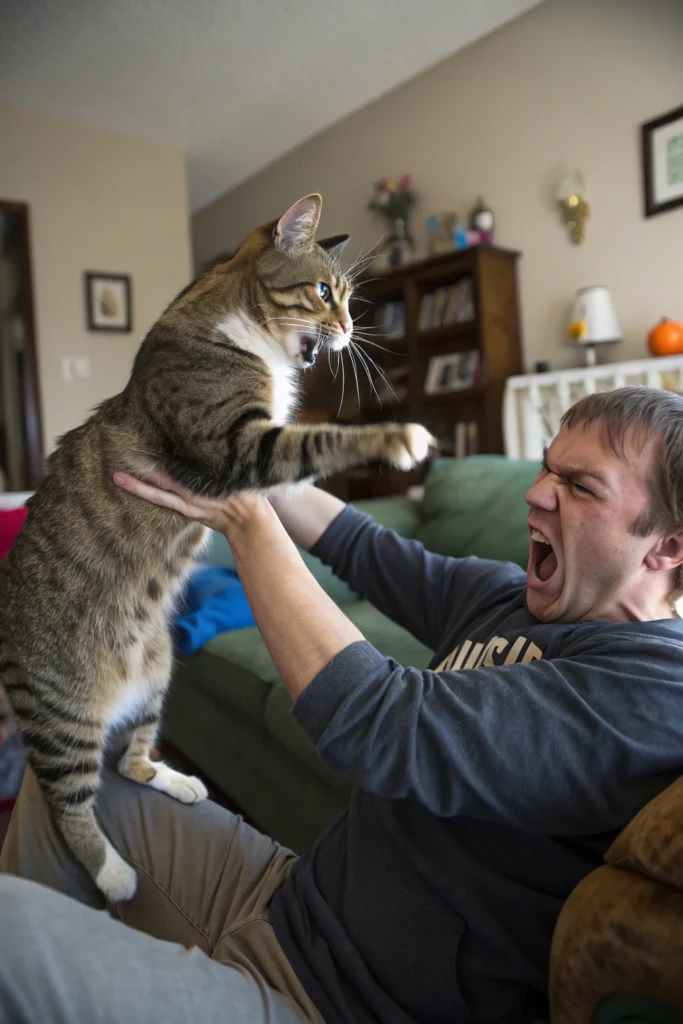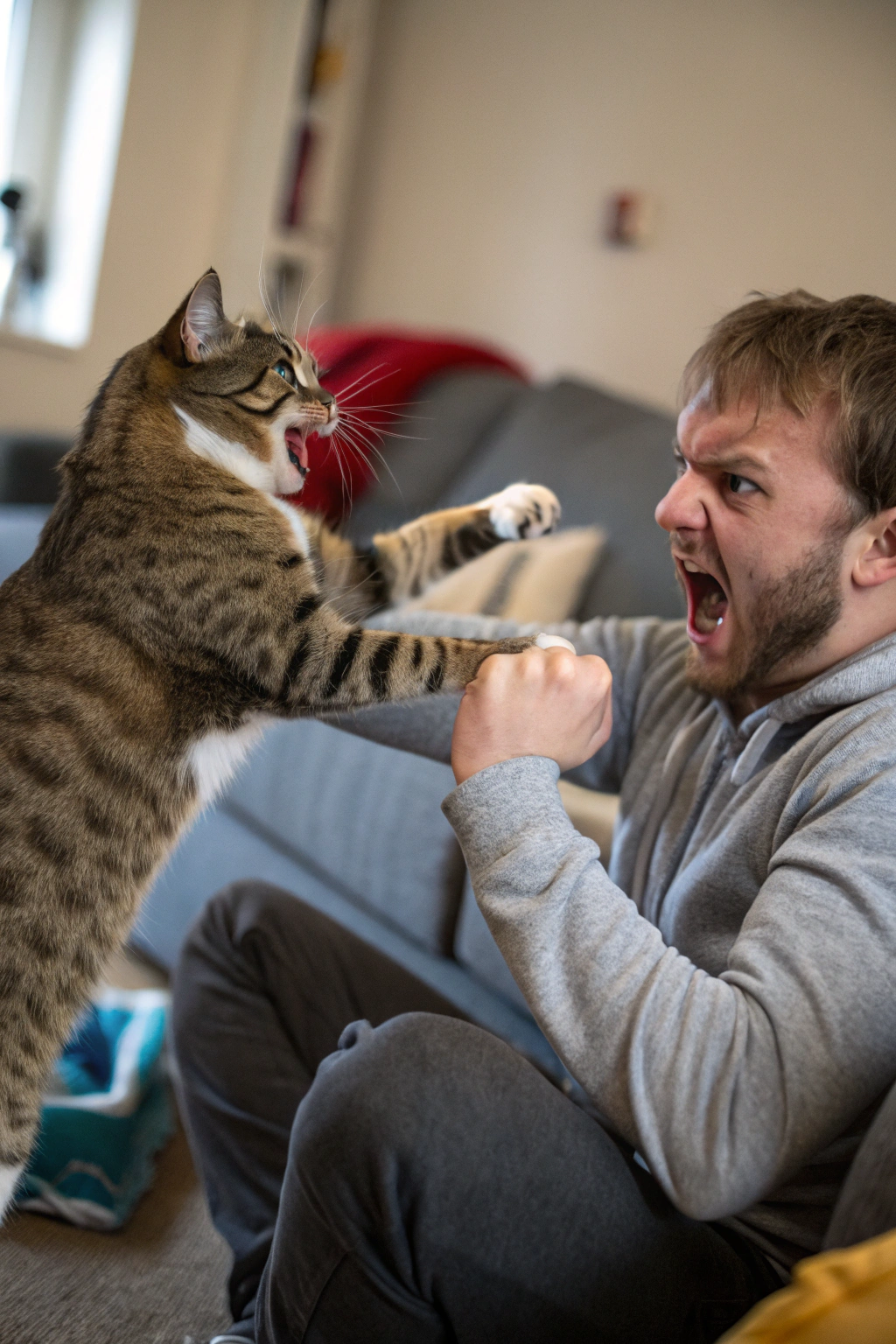There’s few things more startling than a sudden pounce, a sharp nip, or an unexpected swat from your beloved feline friend. You’re petting them one minute, enjoying a quiet moment, and the next – wham! – you’re left wondering, “Why does my cat attack me?” It’s a confusing, sometimes painful, and often perplexing behavior that leaves many cat owners scratching their heads. You think you have a handle on their purrs and head-butts, but then why does my cat attack me throws you for a loop? It’s more common than you think, and understanding the roots of this seemingly random aggression is key to a harmonious home. Let’s dive into the complex world of feline behavior and uncover the secrets behind those sharp claws and teeth.
If you’re asking “why does my cat attack me,” the most common reasons include playtime aggression, redirected aggression, overstimulation, fear, pain, or underlying medical issues. Understanding the triggers and contexts of these attacks is crucial for addressing the behavior effectively.
Table of Contents
Peeling Back the Layers: Common Reasons Why Your Cat Attacks
Understanding the root cause is the first step in addressing aggressive behavior. When you find yourself saying, “my cat viciously attacked me unprovoked,” remember that while it might seem unprovoked from your perspective, there’s almost always a feline logic behind it. Let’s explore the primary motivations behind these sudden pounces and nips.

The Playtime Predator: Instinctual Hunting Behavior
One of the most frequent answers to “why does my cat attack me” lies in their innate hunting instincts. Cats are natural predators, and stalking, chasing, and pouncing are hardwired behaviors. If your cat didn’t have enough appropriate outlets to exercise these instincts during kittenhood, or if they were encouraged to play with hands and feet, they might see your limbs as prey.
- Lack of Proper Play: Not enough interactive toys or playtime can lead to your cat releasing pent-up energy and hunting drive on you. A recent survey found that cats who received less than 15 minutes of active, interactive play per day were significantly more likely to exhibit play-related aggression towards their owners.
- Inappropriate Play: Using your hands or feet as toys teaches your cat that these are acceptable targets for biting and scratching. This is a major reason why do cats randomly attack their owners during seemingly innocent interactions. It’s a learned behavior that’s reinforced every time they successfully “catch” your hand.
- Ambush Play: Cats often hide and pounce as part of their playful hunting sequence. If you’re not providing suitable ambush opportunities (like tunnels or boxes), they might target you from under furniture or around corners. This isn’t malicious; it’s simply them acting on ingrained predatory instincts because you are the most available “prey.”
When Affection Turns Sour: Overstimulation Aggression
Have you ever been enjoying a purr-filled petting session, only for it to abruptly end with a bite or scratch? This is often a case of overstimulation aggression, sometimes referred to as petting-induced aggression. It’s a classic “love bite” scenario but can escalate to more serious nips and scratches.
- Sensory Overload: Pro longed or vigorous petting can overwhelm certain cats, leading to irritation and a sudden defensive reaction. Their skin can become sensitive, and the repetitive motion can be too much. Imagine someone tickling you intensely for too long – you’d likely want it to stop!
- Body Language Missed: Cats often show subtle signs of impending overstimulation (tail twitching, skin rippling, ears flattening, dilated pupils, quick head turns away from you). If these signals are missed, the cat may escalate to a bite to signal they want you to stop. This is a common scenario when owners lament, “why do cats randomly attack me while I’m being affectionate?” Research indicates that many owners miss these early warning signs, leading to the cat feeling they have no other option but to escalate their communication.
- Individual Preference: Some cats have a lower threshold for petting duration or intensity than others. Their comfort levels can also vary depending on their mood or even ambient noise. Getting to know your individual cat’s limits is key.
The Ripple Effect: Redirected Aggression
Redirected aggression is a particularly frustrating and potentially dangerous form of aggression because it often seems to come out of nowhere. This happens when a cat becomes agitated or aroused by something they cannot reach or interact with (like another cat outside, a squirrel, a loud noise, or even a reflected light), and then redirects that aggressive energy onto the nearest, safest target – which is often you.
- External Stimuli: Seeing a rival cat through a window or hearing a frightening noise can trigger a fight-or-flight response. The cat is in a state of high arousal, ready to defend itself or attack the perceived threat.
- In ability to Address the Cause: Because they can’t attack the source of their frustration (the cat behind the glass, the squirrel up the tree), the cat’s pent-up aggression is released onto you, an easier and closer target. This might feel like “my cat viciously attacked me unprovoked,” but it was likely triggered by something you weren’t even aware of happening in the environment.
- Sudden Onset and Intensity: This type of aggression can appear very sudden and intense, making it confusing and frightening for the owner. The cat seems to “snap,” going from calm to highly aggressive in moments. The aggression is directed at you, but the underlying emotion is frustration and fear related to the external trigger.

Fear and Anxiety: The Defensive Attack
Fear and anxiety are powerful motivations for aggression in cats. A cat who feels threatened, trapped, or insecure may resort to biting or scratching as a means of self-defense when they believe they cannot escape the perceived threat.
- New Environments or Changes: Moving to a new home, introducing a new pet (Fido the dog or a new feline friend), or even significant changes to the household routine can make a cat feel insecure and defensive. They are on high alert, perceiving potential threats everywhere.
- Threatening Situations or Perceived Threats: Being cornered, handled roughly or inappropriately, startled unexpectedly, or encountering a perceived threat (like a vacuum cleaner) can provoke a strong fear response. If the cat feels they cannot flee, their only option is to fight.
- Past Trauma: Cats with a history of abuse, neglect, or negative interactions with humans or other animals may be more prone to fear-based aggression. Their trust has been broken, leading to a default defensive stance when approached or handled. If you see your cat retreat then lash out when you reach for them, fear is likely the driving force behind “why does my cat attack me in certain situations?” Look for body language like crouching, wide eyes, flattened ears, and a tucked tail prior to the attack.
The Hidden Pain: Aggression Due to Medical Issues
Sometimes, a sudden or gradual increase in a cat’s aggressive behavior, including biting and scratching, can be a sign of an underlying medical problem. Pain, discomfort, or certain neurological conditions can make a cat irritable, less tolerant of interaction, and more likely to bite or scratch, particularly when touched in a painful area.
- Pain Anywhere: Arthritis (especially common in older cats), dental issues (a very frequent cause of irritability), injuries (visible or internal), urinary tract infections, or other sources of internal pain can make a cat less tolerant of being touched, particularly in sensitive areas or where the pain is located. A gentle stroke that normally feels good might suddenly cause intense pain and elicit a swift, aggressive response as a defense mechanism.
- Neurological Conditions: Certain brain tumors, neurological disorders (like Feline Hyperesthesia Syndrome), or cognitive dysfunction (similar to dementia in humans) can affect a cat’s behavior, temperament, and impulse control, leading to uncharacteristic aggression.
- Hormonal Changes: Unspayed or unneutered cats may exhibit aggression related to hormones, including territorial aggression or increased irritability. While less common as a sudden onset issue in adult cats, it’s a significant factor. Regular vet check-ups are essential to rule out medical causes. If your cat’s aggression has appeared suddenly or is escalating, a trip to the veterinarian should be your first step before pursuing behavioral interventions if you’re wondering “why does my cat attack me so suddenly.”
Addressing the Attacks: Taking Action
Once you have a better understanding of why does my cat attack me, you can start implementing targeted strategies to prevent future incidents. This requires patience, consistency, and sometimes, professional help. Addressing the underlying cause is paramount; simply punishing the cat is ineffective and can worsen the problem by increasing fear and anxiety.
Modifying the Environment
- Enrichment is Key: Provide plenty of opportunities for your cat to express natural behaviors safely. This includes vertical space (cat trees, shelves, perches), scratching posts (both vertical and horizontal), a variety of toys that mimic prey (feathers, mice, wands), and puzzle feeders to engage their minds. Enrichment helps channel their hunting instincts appropriately and reduces boredom, which can be a trigger for “why do cats randomly attack” during play.
- Create Safe Havens: Ensure your cat has quiet, secure places to retreat to where they feel undisturbed, especially in multi-pet households or busy homes. This could be a high shelf, a carrier with a soft bed, or a designated room. Having a safe space reduces anxiety and the likelihood of fear-based or redirected aggression.
- Manage Triggers for Redirected Aggression: If you know what triggers your cat’s redirected aggression (e.g., a specific outdoor cat), try to block their view of the trigger (close curtains or use window film). Distract your cat with a favorite toy or treat when the trigger appears, shifting their focus away from their frustration.
Adjusting Interaction Styles
- Become a Cat Body Language Expert: This is arguably the most important step. Pay close attention to your cat’s subtle signals of discomfort, stress, or overstimulation – flattened ears, dilated pupils, tail twitching rapidly, rippling fur along their back, sudden stillness, a hard stare, or turning their head away. Stop interacting before they reach their threshold for aggression. Learning to read these signals can prevent most overstimulation and fear-based attacks.
- Use Appropriate Play Tools: Always use wands, laser pointers (used correctly and ended with a physical toy), or interactive toys that put a safe distance between your hands and your cat’s claws and teeth during playtime. Never use your hands or feet as toys, even with a kitten. This directly addresses why my cat viciously attacked me unprovoked during play; you are teaching them that human body parts are not prey.
- Keep Petting Sessions Short and Sweet: For cats prone to overstimulation, keep petting sessions brief (3-5 minutes) and enjoyable for your cat. Focus on areas they typically like to be touched (often around the head, neck, and shoulders), and avoid areas that quickly become sensitive, like the belly or lower back, unless your cat specifically solicits attention there. Stop while the cat is still enjoying it, leaving them wanting more.
- Respect Their Boundaries: If your cat walks away or signals they’ve had enough, let them go. Forcing interaction can break trust and increase anxiety, making aggression more likely.

Training and Desensitization
- Positive Reinforcement is Your Friend: Reward calm and desired behaviors with treats, praise, or favorite playtime. This is much more effective than punishment, which can make aggression worse. For example, if your cat approaches calmly without biting, give them a small treat.
- Desensitization and Counter-Conditioning: If your cat is reacting aggressively to specific triggers (the vacuum, a certain person, being picked up), gradually expose them to the trigger at a very low intensity while keeping them calm and providing positive reinforcement (treats, praise). The goal is to change their emotional response from fear/aggression to a positive association. This is best done with guidance from a professional behaviorist.
- Managing Attention-Seeking Aggression: If your cat attacks you for attention (e.g., in the morning for food), never reward the aggression. Do not feed them or give them attention immediately after an aggressive act. Instead, ignore the behavior and wait for a moment of calm before providing attention or food. Increase proactive scheduled playtime and attention throughout the day so they don’t feel the need to resort to aggression to get what they want.
Seeking Professional Help
- Veterinary Consultation: The First Step: It cannot be stressed enough – rule out any and all underlying medical conditions first. Describe the aggression to your vet in detail: when it happens, how often, the intensity, and any triggers you’ve observed. Your vet can perform a physical exam, blood tests, and other diagnostics. If no medical cause is found, they can refer you to a qualified behavior professional.
- Certified Applied Animal Behaviorist (CAAB) or Certified Cat Behavior Consultant (CCBC): For persistent, severe, or complex cases of aggression, particularly those involving fear or redirected aggression, professional help is invaluable. A qualified behaviorist can conduct a thorough assessment of your cat’s history, environment, and behavior patterns to identify the specific causes and develop a tailored, humane behavior modification plan. They are experts in addressing “why does my cat attack me” in intricate situations and can provide hands-on guidance and support.
FAQ: Unpacking Common Questions About Cat Aggression
It’s natural to have many questions when your feline friend is showing aggression. Here are some common concerns and their answers regarding “why does my cat attack me?”.
Q: Why does my cat attack me suddenly for no reason?
A: Often, it seems like there’s “no reason,” but it’s rarely truly unprovoked. It could be redirected aggression from an unseen trigger (like a noise outside), overstimulation from petting where you missed subtle body language signals, or even a sudden pain they experienced when you touched them. Cats are not being malicious; they are reacting based on their instincts, emotions, or physical state.
Q: Why do cats randomly attack ankles and feet?
A: This is typically a form of playful hunting aggression. Moving feet and ankles mimic the movements of prey, triggering your cat’s natural stalking and pouncing instincts. It’s especially common if they didn’t have appropriate outlets or were encouraged to play this way as kittens.
Q: My cat viciously attacked me unprovoked, what should I do immediately?
A: Safety first. Do not try to physically punish or corner your cat. calmly and quietly separate yourself from the cat and give them space to de-escalate in a safe area. Once calm, try to think about what might have happened just before the attack (a noise, something outside, how you were interacting). If the aggression is severe, injures you, or happens frequently, consult a vet immediately.
Q: Is it normal for kittens to attack during play?
A: Play biting and scratching are normal behaviors during kittenhood as they learn hunting skills and bite inhibition from their littermates and mother. However, it’s crucial that you gently discourage biting and scratching human skin and redirect their play to appropriate toys from a young age to prevent these habits from carrying into adulthood.
Q: Why does my cat attack me after I ignore them?
A: Some cats may use aggressive behaviors like nipping or swatting because they’ve learned it’s an effective way to get your attention, whether for food, playtime, or petting. This is a learned behavior if it worked for them in the past. To discourage this, never reward attention-seeking aggression by giving them what they want immediately. Instead, walk away or ignore the behavior, and initiate positive interactions on your terms when they are calm. Increase scheduled playtime and attention.
Q: Could boredom be why do cats randomly attack?
A: Absolutely. Boredom is a significant factor in many behavioral issues, including aggression. A cat who is not mentally or physically stimulated has pent-up energy and unused hunting instincts. They are much more likely to engage in aggressive behaviors directed at their owner (biting, swatting, ambushing) as a way to create excitement and release that energy. Provide plenty of environmental enrichment and interactive playtime.
Q: Why does my cat attack me only when I’m sleeping?
A: This is often a form of play aggression targeting movement under the covers, or it could be attention-seeking behavior if they’ve learned this is the most effective way to wake you up for breakfast or morning interaction. Ensure they have adequate stimulation during the evening hours and consider using automatic feeders if the attacks are food-motivated.
Building a Better Relationship
Dealing with a cat who attacks can be stressful, upsetting, and even frightening. However, by taking the time to understand why does my cat attack me, you’re taking the first crucial step towards resolving the issue and building a stronger, more positive relationship. Remember that your cat isn’t being “mean,” “spiteful,” or trying to dominate you; they are communicating a need, expressing a feeling, or acting on ingrained instincts. Their aggression is usually a sign that something is wrong a signal for help, rather than an act of malice.
Whether it’s addressing playful aggression by providing better outlets, recognizing subtle signs of overstimulation and respecting boundaries, managing redirected frustration by controlling the environment, acknowledging fear and building trust, or diligently investigating potential medical causes with your veterinarian, a thoughtful, patient, and humane approach is key. By enriching their environment, becoming fluent in cat body language, adjusting your interaction styles, and seeking professional help from a certified behaviorist when needed, you can significantly reduce or even eliminate these unwanted behaviors.
Don’t despair and feel helpless if your cat frequently asks “why do cats randomly attack?” through their actions. With patience, understanding, consistency, and the right strategies tailored to your individual cat’s needs, you can build a stronger bond with your feline companion and enjoy a peaceful, happy life together, free from those unexpected pounces and nips. Addressing the heartache of “my cat viciously attacked me unprovoked” starts with unraveling the behavioral mystery, providing your cat with what they truly need, and fostering a relationship built on trust and mutual respect.
Related: how many cat food pouches a day? Your Best 2025 Guide || maine coon australia 2025 your perfect giant pet?





